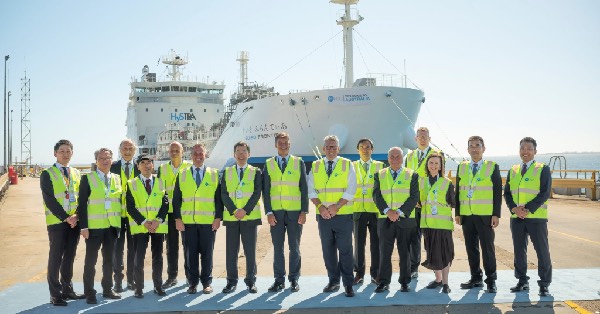The arrival of the world’s first liquefied hydrogen carrier, the Suiso Frontier, in Victoria marks the success of the Hydrogen Energy Supply Chain (HESC) Pilot Project and the dawn of Australia’s hydrogen industry.
HESC’s vision is to produce carbon neutral hydrogen through extraction from a mix of Latrobe Valley coal and biomass, capturing and storing CO2 via the CarbonNet Project and optimising energy efficiency in the HESC supply chain.
The 225,000 tonnes of carbon neutral liquefied hydrogen (LH2) produced by HESC in a commercial phase will contribute to reducing global CO2 emissions by some 1.8 million tonnes per year (equivalent to the emission of about 350,000 petrol-driven cars), while providing valuable infrastructure for other hydrogen projects in the region.
In a commercial phase, the project will create 30,000 full-time jobs across the Gippsland and Mornington Peninsula regions over the life of the project.
During the Pilot Project, 99.999% pure hydrogen has been produced from Latrobe Valley coal and biomass via gasification, trucked to Hastings, cooled to -253 degrees and subsequently liquified to less than 800 times its gaseous volume to create highly valuable liquefied hydrogen.
The loading of liquefied hydrogen onto the Suiso Frontier for the return journey to Kobe, Japan, makes the HESC Project the most advanced and scalable hydrogen project in Australia and the first project in the world to make, liquefy and transport liquid hydrogen by sea to an international market.
The Australia-Japan HESC partnership is at the cutting edge of creating new technology, cleaner energy, and jobs for both countries.
The learnings from the Pilot will form the basis for further work towards delivering HESC at a commercial scale. Over the next two years, the project partners will undertake extensive research and development of the technical and operational requirements for a commercial-scale project.
Activities that will be undertaken include:
- Continuing to test and demonstrate maritime transport of liquid hydrogen with the Suiso Frontier making further trips between Australia and Japan
- Preparing for regulatory approval processes
- Investigating economics of the commercial scale project and its business model
- Engaging potential ‘off-takers’ in Australia and Japan
- Further refining and testing of biomass feed stock for hydrogen production (blending with Latrobe Valley coal)
- Improving technologies to reduce costs and carbon intensity across the supply chain. This includes further development of the ortho-para conversion catalyst for creating LH2 in partnership with CSIRO
- Implementing a comprehensive stakeholder engagement program to continue building a social licence in the communities the project would operate in.
The HESC project partners are: Kawasaki Heavy Industries, Ltd (KHI), Electric Power Development Co., Ltd. (J-POWER), Iwatani Corporation (Iwatani), Marubeni Corporation (Marubeni), AGL Energy (AGL) and Sumitomo Corporation (Sumitomo). Royal Dutch Shell (Shell), ENEOS Corporation and Kawasaki Kisen Kaisha, Ltd. (K-Line) are also involved in the Japanese portion of the project.









































